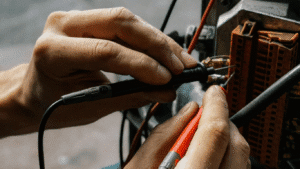When it comes to plumbing, choosing the right type of pipe is crucial for the efficiency and longevity of your plumbing system. Whether you’re a homeowner looking to replace outdated pipes, a DIY enthusiast working on a new project, or a professional plumber searching for the most suitable materials, understanding the best pipes for plumbing is essential. This guide will provide you with comprehensive insights into the types of pipes available, their applications, advantages, and drawbacks, helping you make an informed decision.
1. Types of Plumbing Pipes
Plumbing pipes come in various materials, each with its specific uses and benefits. Here are the most commonly used types of plumbing pipes:
a. Copper Pipes
Copper pipes have been a popular choice for plumbing for decades. Known for their durability and reliability, they are often used in both residential and commercial plumbing systems.
Advantages:
- Longevity: Copper pipes are highly durable and can last up to 50 years or more.
- Corrosion-resistant: They do not corrode easily, making them ideal for water supply lines.
- Safe: Copper is a non-toxic material, ensuring the safety of drinking water.
- Heat resistance: Suitable for hot water lines due to their ability to withstand high temperatures.
- Recyclable: Environmentally friendly as they can be recycled.
Disadvantages:
- Cost: Copper pipes are more expensive than other types.
- Installation: Requires professional installation due to the need for soldering and specific tools.
- Rigid: Less flexible, which can limit their use in some applications.
b. PEX (Cross-linked Polyethylene) Pipes
PEX pipes are a modern, versatile option widely used in residential plumbing. They are especially popular for their flexibility and ease of installation.
Advantages:
- Flexibility: Can be bent and shaped, reducing the need for joints and fittings.
- Cost-effective: Generally cheaper than copper pipes.
- Easy installation: Can be installed quickly and with fewer specialized tools.
- Corrosion-resistant: Do not corrode or develop pinhole leaks like metal pipes.
- Quiet: Less prone to noise from water hammer or vibrations.
Disadvantages:
- UV-sensitive: Should not be exposed to direct sunlight, as UV rays can degrade the material.
- Not recyclable: Less environmentally friendly compared to copper.
- Temperature limitations: While they handle hot water, they may not withstand extremely high temperatures as well as copper.
c. PVC (Polyvinyl Chloride) Pipes
PVC pipes are commonly used for drainage, waste, and vent systems. They are also used for cold water supply lines in some cases.
Advantages:
- Inexpensive: PVC is one of the most cost-effective piping materials.
- Lightweight: Easy to handle and install.
- Corrosion-resistant: Does not rust or corrode, making it suitable for outdoor applications.
- Chemical-resistant: Withstands a wide range of chemicals, making it ideal for industrial applications.
Disadvantages:
- Temperature limitations: Not suitable for hot water lines due to the risk of warping.
- Brittle: Can crack or break under pressure or with age, especially in colder climates.
- Potential toxicity: Contains chemicals that may pose health risks if used in drinking water lines over time.
d. CPVC (Chlorinated Polyvinyl Chloride) Pipes
CPVC pipes are similar to PVC but are treated with chlorine to improve heat resistance. They are used for both hot and cold water supply lines.
Advantages:
- Heat-resistant: Suitable for hot water lines up to 200°F (93°C).
- Corrosion-resistant: Like PVC, they do not rust or corrode.
- Easy to install: Similar installation process as PVC, but with greater temperature tolerance.
Disadvantages:
- Cost: More expensive than PVC, though still cheaper than copper.
- Brittleness: Can become brittle over time, especially in freezing conditions.
- Chemical exposure risk: Not suitable for all chemical environments, which could degrade the material.
e. Galvanized Steel Pipes
Galvanized steel pipes were once the standard for plumbing in older homes but have become less popular due to newer, more efficient materials.
Advantages:
- Durability: Galvanized pipes are strong and can handle high pressure.
- Rust-resistant: Initially resistant to rust due to the zinc coating.
Disadvantages:
- Corrosion over time: Zinc coating wears off, leading to rust and corrosion, which can affect water quality.
- Heavy: Difficult to work with due to their weight.
- Shorter lifespan: Compared to copper or PEX, they have a shorter effective lifespan.
- Potential for lead contamination: In older homes, lead soldering or fittings can pose a health risk.
e. Stainless Steel Pipes
Stainless steel pipes are less commonly used in residential plumbing but are favored in certain commercial applications due to their strength and corrosion resistance.
Advantages:
- High corrosion resistance: Ideal for environments where pipes are exposed to corrosive elements.
- Durability: Very strong and can withstand high pressure and temperature.
Disadvantages:
- Cost: Among the most expensive options for plumbing pipes.
- Installation difficulty: Requires specialized fittings and installation techniques.
- Limited use in residential settings: Typically not necessary for most home plumbing needs.
f. Cast Iron Pipes
Cast iron pipes are primarily used for drainage systems due to their strength and sound-dampening qualities.
Advantages:
- Durability: Extremely durable and can last for over a century.
- Soundproof: Excellent at reducing noise from water flow and waste drainage.
- Fire-resistant: Does not burn, making it safer for certain applications.
Disadvantages:
- Heavy: Very heavy, making them difficult to handle and install.
- Corrosion: Can corrode over time, especially when exposed to water with a low pH.
- Cost: More expensive and labor-intensive to install compared to modern materials.
2. How to Choose the Right Pipe for Your Plumbing Needs
Choosing the right type of pipe depends on several factors, including:
a. Purpose and Location
- Water Supply Lines: Copper and PEX are often the best choices for water supply lines due to their durability and safety.
- Drain, Waste, and Vent (DWV) Systems: PVC, CPVC, and cast iron are commonly used for these applications because they are resistant to corrosion and are suitable for non-pressurized systems.
- Outdoor Use: Stainless steel and PVC are ideal for outdoor applications due to their resistance to environmental elements.
b. Budget
Consider the initial cost and the long-term maintenance costs of the pipes. While copper pipes may have a higher upfront cost, their longevity and minimal maintenance can make them more cost-effective in the long run. PEX and PVC are more affordable options for those with a tighter budget.
c. Water Quality
The type of water in your area can affect pipe material selection. For example, highly acidic or alkaline water can corrode certain pipes faster. Copper is generally safe for most water types, while galvanized steel may corrode more quickly in certain conditions.
d. Climate
Climate plays a significant role in pipe selection:
- Cold Climates: PEX is highly recommended in areas prone to freezing as it can expand without breaking. Copper pipes, if not properly insulated, may burst in freezing temperatures.
- Hot Climates: CPVC and copper are excellent choices due to their ability to withstand high temperatures.
e. Longevity and Maintenance
Consider the lifespan and maintenance requirements of each pipe material. Copper and stainless steel offer exceptional longevity, while PVC and PEX may require more frequent inspections and replacements.
3. Installation Tips for Different Pipe Types
a. Copper Pipes Installation
Installing copper pipes requires some skill and specific tools, including a pipe cutter, a torch, flux, and solder. Here are some tips:
- Preparation: Clean the pipe ends thoroughly before soldering to ensure a strong, leak-proof connection.
- Heat Management: Use a heat shield to protect surrounding areas from the torch flame.
- Testing: After installation, check for leaks by running water through the pipes and inspecting all joints.
b. PEX Pipes Installation
PEX pipes are easier to install than copper, making them popular for DIY projects. Consider the following:
- Tools: A PEX cutter, crimping tool, and fittings are essential for a proper installation.
- Avoid Kinks: When bending PEX pipes, avoid creating kinks, as they can restrict water flow and potentially cause leaks.
- Use Manifolds: Using a manifold system allows for easier control of water flow to various parts of your plumbing system.
c. PVC and CPVC Pipes Installation
PVC and CPVC pipes are straightforward to install with the right adhesive and fittings:
- Cutting: Use a fine-tooth saw or a PVC cutter for clean, straight cuts.
- Priming and Cementing: Always apply primer before the solvent cement to ensure a secure bond.
- Proper Ventilation: Ensure good ventilation when working with PVC cement, as the fumes can be harmful.
4. Conclusion: Finding the Best Pipes for Your Plumbing Needs
Selecting the right plumbing pipe depends on various factors, including the application, budget, water quality, and climate. Copper, PEX, PVC, CPVC, galvanized steel, stainless steel, and cast iron each have their specific benefits and drawbacks. Understanding these materials’ properties and best uses will help you make an informed decision and ensure the longevity and efficiency of your plumbing system.
5. Frequently Asked Questions (FAQs)
Q1: What is the best pipe material for a home plumbing system?
Answer: For most home plumbing systems, copper and PEX are highly recommended due to their durability, safety, and ease of installation. PEX is particularly popular for its flexibility and cost-effectiveness, while copper is valued for its longevity and resistance to corrosion.
Q2: Can PEX pipes be used for both hot and cold water lines?
Answer: Yes, PEX pipes are suitable for both hot and cold water lines. They are designed to withstand high temperatures and can handle hot water systems effectively.
Q3: Are PVC pipes safe for drinking water?
Answer: PVC pipes are generally not recommended for drinking water as they may contain chemicals that could leach into the water. CPVC, on the other hand, is treated to be safe for hot and cold water lines, including potable water.
Q4: How long do galvanized steel pipes last?
Answer: Galvanized steel pipes typically last between 20 to 50 years, depending on water quality and maintenance. Over time, they can corrode and rust, which may lead to leaks and potential contamination of the water supply.
Q5: What should I consider when choosing a pipe material for my home?
Answer: Consider factors such as the pipe’s purpose, location, budget, water quality, climate, and desired longevity. Consulting with a professional plumber can also help determine the best choice for your specific needs.




